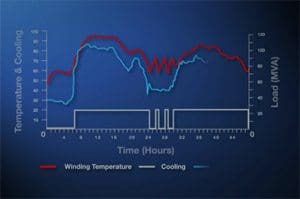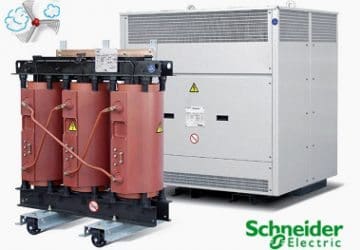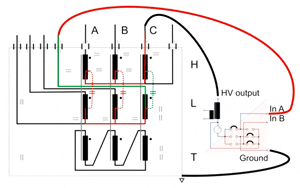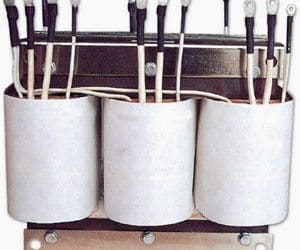Transformer Protection – Abstract from NEC
According to NEC 450.4, “each transformer 600 volts, nominal, or less shall be protected by an individual overcurrent device installed in series with each ungrounded input conductor.” Such overcurrent device shall be rated or set at not more than 125%… Read more
Dec 26, 2011 | By Jignesh Parmar

Why and how much for fire protection of power plant?
Fire protection measures can be subdivided into life-safety and investment categories. Life-safety measures are considered to be mandatory by fire codes, building codes, or safety codes. As such, the codes mandate specific types of substation fire protection, with very little… Read more
Dec 07, 2011 | By Edvard Csanyi

Transformer and Transformer-Feeder Protection
The development of modern power systems has been reflected in the advances in transformer design. This has resulted in a wide range of transformers with sizes ranging from a few kVA to several hundred MVA being available for use in… Read more
Nov 30, 2011 | By Edvard Csanyi

What Standards To Use For Transformer Oil Testing?
ASTM (American Society for Testing and Materials) has developed the standards for oil testing. The following tests we recommended for a complete analysis of a transformer’s oil: The dielectric breakdown is an indication of the oil’s ability to withstand electrical…...
Membership Upgrade Required
This content is not available in your premium membership plan. Please upgrade your plan in order to access this content. You can choose an annually based Basic, Pro, or Enterprise membership plan. Subscribe and enjoy studying specialized technical articles, online video courses, electrical engineering guides, and papers.With EEP's premium membership, you get additional essence that enhances your knowledge and experience in low- medium- and high-voltage engineering fields.
Black Friday Deal 💥 - Save 20% on Pro Plan with code BLACKFRIDAY
Upgrade
Nov 15, 2011 | By Edvard Csanyi

Installation of Distribution-to-Utilization Voltage Transformers
Aerial transformer installations may utilize a three-phase unit or banked single-phase units. Transformers, either singly or in banks, having an individual unit or combined capacity greater than 300 kVA will not be mounted on single wood poles. Special structural considerations… Read more
Nov 11, 2011 | By Edvard Csanyi

Sources of Sound in Transformers
Unlike cooling-fan or pump noise, the sound radiated from a transformer is tonal in nature, consisting of even harmonics of the power frequency. It is generally recognized that the predominant source of transformer noise is the core. The low frequency,… Read more
Nov 09, 2011 | By Edvard Csanyi

Transformer Winding Faults
A fault on a transformer winding is controlled in magnitude by the following factors: Source impedance Neutral earthing impedance Transformer leakage reactance Fault voltage Winding connection Several distinct cases arise and are examined below. The winding earth fault current depends… Read more
Nov 02, 2011 | By Edvard Csanyi

Transformer Testing Techniques
Cant see this video? Click here to watch it on Youtube. Substation transformers can range from the size of a garbage can to the size of a small house; they can be equipped with a wide array of gauges, bushings,… Read more
Oct 27, 2011 | By Edvard Csanyi

Forced ventilation cycles in Trihal transformers
Transformers, when in operation, are subject to no-load losses and load losses. This energy causes a rise in the temperature of the transformer’s active part, i.e. the magnetic core and the windings. It is therefore normal for the transformer to… Read more
Oct 22, 2011 | By Edvard Csanyi

Diagnosing Transformer Winding Insulation (video)
This video tutorial shows the progression of power factor or dissipation factor over frequency. Furthermore, measuring transformer winding insulation, including the connection of measuring leads, is explained. Reasons why recording frequency responses is important for a correct diagnosis of a… Read more
Sep 25, 2011 | By Edvard Csanyi

Understanding Transformer Polarity
With power or distribution transformers, polarity is important only if the need arises to parallel transformers to gain additional capacity or to hook up three single-phase transformers to make a three-phase bank. The way the connections are made affects angular… Read more
Sep 23, 2011 | By Edvard Csanyi

Difference between Power Transformer and Distribution Transformer
Power transformers are used in transmission network of higher voltages for step-up and step down application (400 kV, 200 kV, 110 kV, 66 kV, 33kV) and are generally rated above 200MVA. On the other hand, distribution transformers are used for… Read more
Aug 27, 2011 | By Jignesh Parmar

Autotransformers in few words
It is possible to obtain transformer action by means of a single coil, provided that there is a “tap connection” somewhere along the winding. Transformers having only one winding are called autotransformers, shown schematically in figure 1. An autotransformer has… Read more
Aug 19, 2011 | By Edvard Csanyi

Life Cycle Cost of Transformers
To perform the economical analysis of transformer, it is necessary to calculate its life cycle cost, sometimes called total cost of ownership, over the life span of transformer or, in other words, the capitalised cost of the transformer. All these… Read more
Aug 06, 2011 | By Edvard Csanyi

Buchholz relay on oil transformer with conservator
The Buchholz relay has two oil-filled chambers with floats and relays arranged vertically one over the other. If high eddy currents, local overheating, or partial discharges occur within the tank, bubbles of resultant gas rise to the top of the… Read more
Jun 20, 2011 | By Edvard Csanyi


